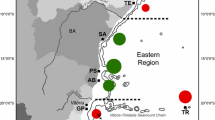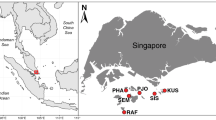Abstract
The Hawaiian Islands represent one of the most geographically remote locations in the Indo-Pacific, and are a refuge for rare, endemic life. The diversity of symbiotic dinoflagellates (Symbiodinium sp.) inhabiting zooxanthellate corals and other symbiotic cnidarians from the High Islands region was surveyed. From the 18 host genera examined, there were 20 genetically distinct symbiont types (17 in clade C, 1 in clade A, 1 in clade B, and 1 in clade D) distinguished by internal transcribed spacer region 2 sequences. Most “types” were found to associate with a particular host genus or species and nearly half of them have not been identified in surveys of Western and Eastern Pacific hosts. A clear dominant generalist symbiont is lacking among Hawaiian cnidarians. This is in marked contrast with the symbiont community structures of the western Pacific and Caribbean, which are dominated by a few prevalent generalist symbionts inhabiting numerous host taxa. Geographic isolation, low host diversity, and a high proportion of coral species that directly transmit their symbionts from generation to generation are implicated in the formation of a coral reef community exhibiting high symbiont diversity and specificity.




Similar content being viewed by others
References
Baker AC (2001) Corals bleach to survive change. Nature 411:765–766
Baker AC (2003) Flexibility and specificity in coral-algal symbiosis: diversity, ecology and biogeography of Symbiodinium. Ann Rev Ecol Evol Syst 34:661–689
Baker AC, Rowan R (1997) Diversity of symbiotic dinoflagellates (zooxanthellae) in scleractinian corals of the Caribbean and eastern Pacific. Proc 8th Int Coral Reef Symp 2:1301–1306
Buddemeier RW, Fautin DG (1993) Coral bleaching as an adaptive mechanism. BioScience 43:320–326
Clague DA, Dalrymple GB (1987) In: Volcanism in Hawaii. Decker RW, Wright TL, Stauffer PH (eds) US Govt Printing Office pp 5–54
Coffroth MA, Santos SR, Goulet TL (2001) Early ontogenic expression of specificity in a cnidarian-algal symbiosis. Mar Ecol Prog Ser 222:85–96
Diekmann OE, Olsen JL, Stam WT, Bak RPM (2003) Genetic variation within Symbiodinium clade B from the coral genus Madracis in the Caribbean (Netherlands Antilles) Coral Reefs 22:29–33
Douglas AE (1998) Host benefit and the evolution of specialization in symbiosis. Heredity 81:599–603
Futuyma DJ, Moreno G (1988) The evolution of ecological specialization. Ann Rev Ecol Syst 19:207–233
Glynn PW, Mat JL, Baker AC, Calderon MO (2001) Coral bleaching and mortality in Panama and Ecuador during the 1997–1998 El Nino-southern oscillation event: spatial/temporal patterns and comparisons with the 1982–1983 event. Bull Mar Sci 69:79–109
Hoegh-Guldberg O (1999) Climate change, coral bleaching and the future of the world’s coral reefs. Mar Freshwater Res 50:839–866
Huelsenbeck JP, Ronquist F (2001) MrBays: Bayesian inference of phylogenetic trees. Bioinformatics 17:754–755
Hughes TP, Bellwood DR, Connolly SR (2002) Biodiversity hotspots, centers of endemicity, and the conservation of coral reefs. Ecol Lett 5:775–784
Hunter CL (1988) Genotypic diversity and population structure of the Hawaiian reef coral Porites compressa. Dissertation. University of Hawaii, 136 pp
Iglesias-Prieto R, Trench RK (1997) Photoadaptation, photoacclimation and niche diversification in invertebrate-dinoflagellate symbioses. Proc 8th Int Coral Reef Symp 2:1319–1324
Iglesias-Prieto R, Beltrán VH, LaJeunesse TC, Reyes-Bonilla H, Thomé PE (2004) Different algal symbionts explain the vertical distribution of dominant reef corals in the eastern Pacific. Proc R Soc Lond 271: 1757-1763
Jokiel PL (1987) Ecology, biogeography and evolution of corals in Hawaii. TREE 2:179–182
Jokiel PL, Brown EK (2004) Global warming, regional trends and inshore environmental conditions influence coral bleaching in Hawaii. Global Change Biol
Jokiel PL, Coles SL (1990) Response of Hawaiian and other Indo-Pacific reef corals to elevated temperature. Coral Reefs 8:155–162
Kay AE, Paulumbi SR (1987) Endemism and evolution in Hawaiian marine invertebrates. TREE 2:183–186
Kinzie RA (1996) Modes of speciation and reproduction in archaeocoeniid corals. Galaxea 13:47–64
LaJeunesse TC (2001) Investigating the biodiversity, ecology, and phylogeny of endosymbiotic dinoflagellates in the genus Symbiodinium using the internal transcribed spacer region: in search of a “species” level marker. J Phycol 37:866–880
LaJeunesse TC (2002) Diversity and community structure of symbiotic dinoflagellates from Caribbean coral reefs. Mar Biol 141:387–400
LaJeunesse TC, Trench RK (2000) The biogeography of two species of Symbiodinium (Freudenthal) inhabiting the intertidal anemone, Anthopleura elegantissima (Brandt). Biol Bull 199:126–134
LaJeunesse TC, Loh WKW, van Woesik R, Hoegh-Guldberg O, Schmidt GW, Fitt WK (2003) Low symbiont diversity in southern Great Barrier Reef corals relative to those of the Caribbean. Limnol Oceanogr 48:2046–2054
LaJeunesse TC, Bhagooli R, Hidaka M, Done T, deVantier L, Schmidt GW, Fitt WK, Hoegh-Guldberg (2004) Closely-related Symbiodinium spp. differ in relative dominance within coral reef host communities across environmental, latitudinal, and biogeographic gradients. Mar Ecol Prog Ser
Law R (1985) Evolution in a mutualistic environment. In: Boucher DH (ed) The biology of mutualism: ecology and evolution. Oxford University Press, New York, pp 145–170
Loh WK, Loi T, Carter D, Hoegh-Guldberg O (2001) Genetic variability of the symbiotic dinoflagellates from the wide ranging coral species Seriatopora hystrix and Acropora longicyathus in the Indo-West Pacific. MEPS 222:97–107
Loya Y, Sakai K, Yamazato K, Nakano Y, Sambali H, Van Woesik R (2001) Coral bleaching: the winners and the losers. Ecol Lett 4:122–131
Maragos JE (1995) Revised checklist of extant shallow-water coral species from Hawaii (Cnidaria: Anthozoa: Scleractinia). Bishop Museum Occ Papers 42:54–55
Pochon X, Pawlowski J, Zaninetti L, Rowan R (2001) High genetic diversity and relative specificity among Symbiodinium -like endosymbiotic dinoflagellates in soritid foraminiferans. Mar Biol 139:1069–1078
Richmond RH, Hunter CL (1990) Reproduction and recruitment of corals: comparisons among the Caribbean, the tropical Pacific and the Red Sea. MEPS 60:185–203
Rodriguez-Lanetty M, Krupp D, Weis VM. (2004) Distinct ITS types of Symbiodinium in clade C correlate to cnidarian/dinoflagellate specificity during symbiosis onset. Mar Ecol Prog Ser 275:97-102
Rowan R, Powers DA (1991) A molecular genetic classification of zooxanthellae and the evolution of animal-algal symbiosis. Science 251:1348–1351
Rowan R, Knowlton N, Baker A, Jara J (1997) Landscape ecology of algal symbionts creates variation in episodes of coral bleaching. Nature 388:265–269
Ryland JS (1997) Reproduction in zoanthidea (Anthozoa: Hexacorallia) Invert. Reprod Dev. 31:177–188
Santos SR, Taylor DJ, Coffroth MA (2001) Genetic comparisons of freshly isolated vs. cultured symbiotic dinoflagellates: implications for extrapolating to the intact symbiosis. J Phycol 37:900–912
Santos SR, Shearer TL, Hannes AR, Coffroth, MA (2004) Fine-scale diversity and specificity in the most prevalent lineage of symbiotic dinoflagellates (Symbiodinium, Dinophyceae) of the Caribbean. Molec Ecol 13:459–469
Seutin G, White BN, Boag PT (1991) Preservation of avian blood and tissue samples for DNA analyses. Can J Zool 69:82–92
Simon C (1987) Hawaiian evolutionary biology: an introduction. TREE 2:175–178
Speksnijder AGCL, Kowalchuk GA, De Jong S, Kline E, Stephan JR, Laanbroek HJ (2001) Microvariation artifacts introduced by PCR and cloning of closely related 16S rRNA gene sequences. Appl Environ Microbiol 67:469–472
Swofford DL (1999) PAUP*, Phylogenetic Analysis Using Parsimony (*and other methods), Version 4.0b10, Sinauer, Sunderland, Mass.
Veron JEN (1995) Corals in space and time. UNSW Press, Sydney, pp 321
Weis VM, Reynolds WS, deBoer MD, Krupp DA (2001) Host-symbiont specificity during onset of symbiosis between the dinoflagellates Symbiodinium spp. and planula larvae of the scleractinian coral Fungia scutaria. Coral Reefs 20:301–308
Wilkinson DM (2001) Horizontally acquired mutualisms, an unsolved problem in ecology? Oikos 92:377–384
Acknowledgments
The authors thank the participants in the Hawaii Institute of Marine Biology’s “Molecular biology of corals”, Edwin W. Pauley summer program of 2002. CBS Scientific generously loaned their DGGE electrophoresis system for this course. Cynthia L. Hunter for helpful discussions and field assistance. T.C.L thanks Michael P. Lesser and Jo-Ann Leong for facilitating his course participation and stay on Coconut Island. This work was supported by the Edwin W. Pauley foundation, National Science Foundation grant OCE- 0137007 to WK Fitt and GW Schmidt, a grant from the Smithsonian Center for Caribbean Research, and a NSF graduate research fellowship to D. J. Thornhill.
Author information
Authors and Affiliations
Corresponding author
Additional information
Communicated by H.R. Lasker
Rights and permissions
About this article
Cite this article
LaJeunesse, T.C., Thornhill, D.J., Cox, E.F. et al. High diversity and host specificity observed among symbiotic dinoflagellates in reef coral communities from Hawaii. Coral Reefs 23, 596–603 (2004). https://doi.org/10.1007/s00338-004-0428-4
Received:
Accepted:
Published:
Issue Date:
DOI: https://doi.org/10.1007/s00338-004-0428-4




